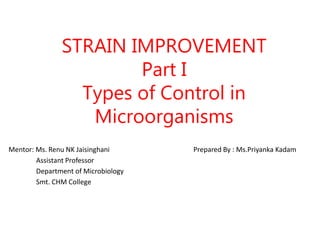
Strain improvement part I, Types of control mechanism in micro-organisms
- 1. STRAIN IMPROVEMENT Part I Types of Control in Microorganisms Mentor: Ms. Renu NK Jaisinghani Prepared By : Ms.Priyanka Kadam Assistant Professor Department of Microbiology Smt. CHM College
- 2. DEFINITION OF STRAIN IMPROVEMENT: It is a process of modifying genotype of organism so as to make it a better industrial strain than existing one with respect to yield or any other property that makes the process economic and simple.
- 4. MUTATION: Isolation of induced mutants using Physical (uv , X rays , gamma rays ,etc.) or Chemical (NTG, alkylating agents, 2 amino purine ). RECOMBINATION: By selecting new recombinants by using recombination technique like sexual recombination, parasexual cycle, transformation, conjugation transduction, lysogeny, phage conversion, spheroplast / protoplast fusion.
- 5. PRINCIPLE: Underlying strain improvement method is to modify genotype of natural industrially important isolate by mutation or recombination so as to make it much better industrial strain that is high yielding, more suitable for fermentation process and makes the process economic.
- 6. SIGNIFICANCE/ IMPORTANCE/ ADVANTAGES OF STRAIN IMPROVEMENT: 1. It helps in obtaining higher yielding strain, 2. It helps in obtaining more stable strain. 3. It helps in obtaining strain that makes the process economic. 4. Helps in selecting strain with better properties like resistance to phage , non-foaming, requiring low oxygen tension, not producing undesirable by-product , etc.
- 7. Before studying methods of selecting strain giving higher yield it is necessary to study mechanism of control of their biosynthesis to construct “ blue prints” of useful organisms. Two main systems involved in regulation of production of primary metabolites: FBI [Feed back Inhibition] FBR [ Feed Back Repression]
- 8. FEED BACK INHIBITION [FBI]- Is the situation where product of a biochemical pathway inhibits the activity of enzyme catalyzing one of reactions of the pathway ( normally the 1st reaction). Inhibition occurs because products bind with enzyme. Catalyzing reaction may / may not be at allosteric site and interfere with binding of enzyme with substrate and thus stops further synthesis of product.
- 9. FEED BACK REPRESSION[FBR]: is the situation where end product of biochemical pathway prevents the synthesis of enzyme/enzymes catalyzing the reaction / reactions of the pathway. Inhibition occurs at gene level as product prevents the transcription of gene (coding for enzyme) in mRNA and thereby its synthesis.
- 10. Such regulation systems (FBI and FBR) plays important role in organism and helps in avoiding wastage of ‘E’ in over synthesis of any product. Micro organism will always synthesize any product in amount just enough for their survival and growth. The control of biosynthetic pathway giving no. of end products ( branched pathway)is more complex than simple unbranched pathway. The end products of same branched biosynthetic pathway are rarely required by micro-organisms to the same extent, therefore if an end product exerts control over a part of pathway common to two or more end products then organisms may suffer deprivation of products not participating in the control. Thus regulation mechanism in an organism is such that synthesis of end products of branched pathway is controlled without depriving the cell of essential intermediates.
- 11. There are 5 main types of regulation systems studied in organism that control branched pathways of biosynthesis CONCERTED FEED BACK CONTROL CO OPERATIVE FEED BACK CONTROL CUMULATIVE FEED BACK CONTROL SEQUENTIAL FEED BACK CONTROL ISOENZYME FEED BACK CONTROL
- 12. 1. CONCERTED FEED BACK CONTROL: It involves the control of pathway by more than one end product i.e enzyme of pathway is inhibited only when all the end products of the pathway are in excess.
- 13. 2.COOPERATIVE FEED BACK CONTROL: The presence of all the end products in excess results in a synergistic inhibition by inhibiting 1st enzyme of the pathway but weak control may be exerted by each product independently . When any one product is in excess , it can exert weak inhibition just after the branched point leading to the excess of product and thus flow of intermediate product will be diverted to the product which is still required.
- 14. 3. CUMULATIVE FEED BACK CONTROL: Each end product of pathway exerts inhibition of 1st enzyme by 50% independent of other end products ; total inhibition occurs when both the products of pathway are in excess. Also each end product can exert complete inhibition just after the branched point.
- 15. 4.SEQUENTIAL FEED BACK CONTROL: Each end product of the pathway controls the enzyme after the branched point to the product. The intermediate product then accumulates and can inhibit its own synthesis.
- 16. 5.ISOENZYME FEED BACK CONTROL: Let E1 and E2 be the two isoenzymes [enzymes having different form but catalysing same reaction]. In such case different isoenzymes may be controlled by different end products.
- 17. Reference • Stanbury, P.F., Whitaker, A. Principles of Fermentation Technology 2E.
- 18. THANK YOU
